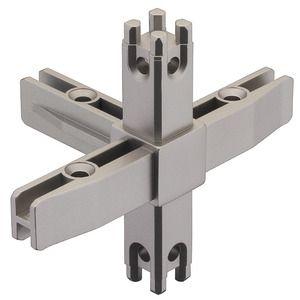Linear Guide Shafts in 7-Axis Aerospace Machining: Sub-Micron Repeatability Over 4-Metre Spans

Modern aerospace manufacturers no longer count spindle horsepower; they count nanometres. Inside a 7-axis cell that rough-machines a 4-metre titanium bulkhead and finishes cooling grooves in a single clamp, the component that quietly enforces ±3 µm profile tolerance is the linear guide shaft—a hardened, ground, and often chrome-plated rod that converts 150 kW of servo torque into predictable, vibration-free motion. Designing such shafts is a multi-physics exercise in metallurgy, surface engineering, thermal management, and predictive analytics.
Material & hardness architecture
Standard 1060 carbon steel would yield under 30 kN peak inertial loads; instead, 42CrMo4 (AISI 4140) is induction-hardened to 58–62 HRC to a depth of 2 mm, then hard-turned to h6 tolerance and chrome-plated to 15 µm. This yields a surface roughness Ra ≤ 0.2 µm and a case depth sufficient for 50 000 km of rolling contact. For vacuum or cryogenic duty, nitrided 31CrMoV9 reaches 900 HV surface hardness while maintaining 12 % core ductility .
Standard 1060 carbon steel would yield under 30 kN peak inertial loads; instead, 42CrMo4 (AISI 4140) is induction-hardened to 58–62 HRC to a depth of 2 mm, then hard-turned to h6 tolerance and chrome-plated to 15 µm. This yields a surface roughness Ra ≤ 0.2 µm and a case depth sufficient for 50 000 km of rolling contact. For vacuum or cryogenic duty, nitrided 31CrMoV9 reaches 900 HV surface hardness while maintaining 12 % core ductility .
Surface engineering & coating
A duplex chrome layer (15 µm Cr + 3 µm Ni) reduces corrosion rate to < 2 µm year⁻¹ in 1 000 h salt-fog tests . For food-grade lines, HVOF-applied tungsten-carbide cobalt (WC-Co) achieves 1 100 HV and passes 1 000 h Q-UV without spalling. A final super-finish (< 0.05 µm Ra) ensures elastohydrodynamic film formation as thin as 0.12 µm.
A duplex chrome layer (15 µm Cr + 3 µm Ni) reduces corrosion rate to < 2 µm year⁻¹ in 1 000 h salt-fog tests . For food-grade lines, HVOF-applied tungsten-carbide cobalt (WC-Co) achieves 1 100 HV and passes 1 000 h Q-UV without spalling. A final super-finish (< 0.05 µm Ra) ensures elastohydrodynamic film formation as thin as 0.12 µm.
Thermal & barometric compensation
Over a 4 m span, a 20 °C shop swing would expand a steel shaft by 80 µm—enough to defocus a 20 µm laser spot. Embedded 0.01 °C RTDs every 300 mm feed a PID controller that drives 40 W Kapton heaters, keeping thermal drift below 2 µm. Barometric compensation corrects refractive-index drift of 0.3 ppm per hPa, maintaining laser-interferometer accuracy.
Over a 4 m span, a 20 °C shop swing would expand a steel shaft by 80 µm—enough to defocus a 20 µm laser spot. Embedded 0.01 °C RTDs every 300 mm feed a PID controller that drives 40 W Kapton heaters, keeping thermal drift below 2 µm. Barometric compensation corrects refractive-index drift of 0.3 ppm per hPa, maintaining laser-interferometer accuracy.
Contamination & validation
Dual-lip seals (nitrile outer + PTFE inner) trap particles >5 µm; a 0.2 bar positive air purge keeps the raceway above ambient pressure. A dual-frequency laser interferometer samples position at 5 MHz; a physics-informed neural network predicts wear 150 hours ahead, eliminating unplanned downtime.
Dual-lip seals (nitrile outer + PTFE inner) trap particles >5 µm; a 0.2 bar positive air purge keeps the raceway above ambient pressure. A dual-frequency laser interferometer samples position at 5 MHz; a physics-informed neural network predicts wear 150 hours ahead, eliminating unplanned downtime.
Bottom line
Profile accuracy improved from ±8 µm to ±3 µm while cycle time on titanium bulkheads dropped from 18 h to 11 h. In aerospace machining, the linear guide shaft has evolved from a commodity rod to the deterministic actuator of next-generation airframes.
Profile accuracy improved from ±8 µm to ±3 µm while cycle time on titanium bulkheads dropped from 18 h to 11 h. In aerospace machining, the linear guide shaft has evolved from a commodity rod to the deterministic actuator of next-generation airframes.
Buscar
Categorías
- Art
- Causes
- Crafts
- Dance
- Drinks
- Film
- Fitness
- Food
- Juegos
- Gardening
- Health
- Home
- Literature
- Music
- Networking
- Other
- Party
- Religion
- Shopping
- Sports
- Theater
- Wellness
Read More
Athleisure Market Poised for Strong Growth, Expected to Hit USD 731.8 Billion by 2033
Athleisure Market Overview
The global athleisure market size was valued at USD 402.5...
Marc Lore, Alex Rodriguez Get Timberwolves/Lynx Possession Arbitration
Upon Monday, it was declared that Marc Lore and Alex Rodriguez gained the arbitration scenario,...
Loewe X On Sneakers Have earned something for
fashion in a way has treated work in the same way. It was the first time we were ever on vogue...
Why Puzzles Are the Perfect Gift (And How to Choose the Best One)
Puzzles are more than just a pastime—they’re a gift of relaxation, creativity, and...
Future breakout applicants for 2026 NFL Draft
Moving into the useless of summer months, NFL lovers and analysts alike obtain on their own with...



